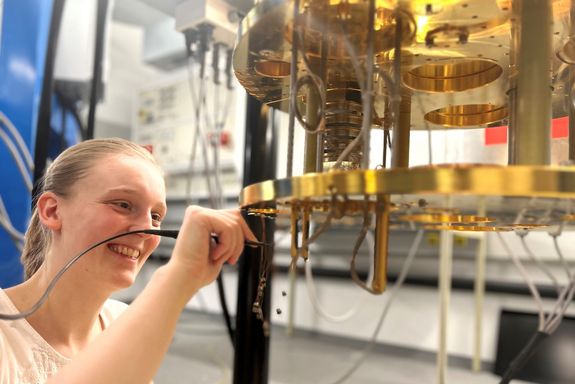Since the 1970s, scientists have speculated whether materials could exist that exhibit a very particular form of magnetic disorder—so-called quantum spin liquids (QSLs).
Such materials are of great interest for several reasons. They could hold the key to developing new types of superconductors, and they may open up novel possibilities in the field of quantum computing and related technologies. But real quantum spin liquids have proven extremely difficult to find. Many experiments have been done, in particular on two-dimensional materials. But even though promising features of a QSL have been found, there has never been full agreement between experiment and theory.
Now, an international team involving TU Wien, Rice University in Texas, the University of Toronto, Rutgers University, and several Neutron Scattering Facilities has identified the first compelling candidate for a genuine three-dimensional quantum spin liquid. Experiments on cerium zirconate (Ce₂Zr₂O₇) revealed key signatures expected for such a state—including so-called emergent photons. These are not actual photons but magnetic excitations within the material that behave in a way that is strikingly similar to photons. The findings were recently published in the journal Nature Physics.
Ordered Magnets, Disordered Liquid
In ordinary magnets, the spins—the quantum mechanical angular momentum of particles—align into regular patterns. For example, in a ferromagnet, all spins point in the same direction below a certain critical temperature.
But there are also materials in which, even at absolute zero, the spins refuse to settle into any static configuration. Instead, they remain in a state of constant quantum fluctuation.
“They behave like a liquid form of magnetism—without any fixed ordering,” explains Prof. Silke Bühler-Paschen of the Institute of Solid State Physics at TU Wien.
A quantum spin liquid is therefore not a liquid in the traditional sense—it is a solid crystal. The term "liquid" refers to the absence of magnetic order in the spin system.
Although the individual spins in such a system remain disordered and point in various directions, they are still quantum mechanically entangled. Their directions appear random, but they are fundamentally linked: A measurement of one spin can affect the state of others. This entanglement is what makes quantum spin liquids such a promising platform for future quantum technologies.
Emergent Photons – Light That Isn't Light
Demonstrating that a material truly forms a quantum spin liquid is exceptionally difficult.
“That’s exactly why a real breakthrough in this area has remained elusive for decades,” says Silke Bühler-Paschen. “We studied cerium zirconate, which forms a three-dimensional network of spins and shows no magnetic ordering even at temperatures as low as 20 millikelvin. For the first time, we were able to detect signals that strongly indicate a three-dimensional quantum spin liquid—particularly, the presence of so-called emergent photons.”
Just like waves can travel through liquid water when it is disturbed, waves can propagate through the spin system of a quantum spin liquid. These waves behave in many ways like light, even though they are not electromagnetic in nature, but rather collective excitations of a large number of spins. Yet mathematically, they follow the same equations as real photons in electrodynamics. The observed signals match theoretical predictions in terms of energy, momentum, and polarization.
“The discovery of these emergent photons in cerium zirconate is a very strong indication that we have indeed found a quantum spin liquid,” says Silke Bühler-Paschen. “We plan to conduct further experiments, but from our perspective, cerium zirconate is currently the most convincing candidate for a quantum spin liquid.” Further high-resolution studies and investigations of related materials are already being planned.
Original publication
Contact
Prof. Silke Bühler-Paschen
Institute for Solid State Physics
TU Wien
+43 1 58801 13716
silke.buehler-paschen@tuwien.ac.at
